Januarius Zick
Johann Rasso Januarius Zick (6 February 1730 – 14 November 1797) was a German painter and architect. He is considered to be one of the main masters of the Late-Baroque.
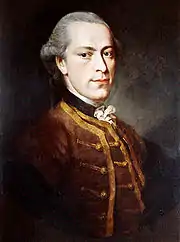
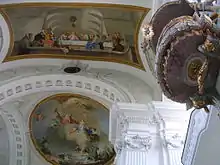
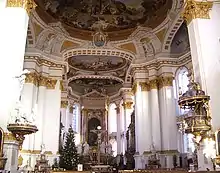
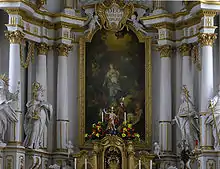
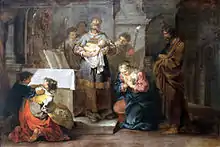
Life
Januarius Zick was born in Munich and began to learn his trade from his father, Johannes Zick, a renowned painter himself, to whom he was apprenticed in order to learn how to paint frescoes. In 1744, when Januarius Zick was fourteen years old, his brother, three years his junior, fell to his death from a scaffolding in Weingarten. From 1745 to 1748, Januarius Zick was apprenticed as a bricklayer to Jakob Emele in Schussenried. Having finished his apprenticeship, he worked, together with his father, at the residence of the Prince-Bishop of Würzburg and then, until the mid-1750s, at the residence of the Prince-Bishop of Speyer in Bruchsal.
In 1756, Januarius Zick went to Paris for further education. There, he came into contact with artists and art connoisseurs from Rome, Basel and Augsburg, who broadened his horizon concerning his art and had a considerable influence on him.
After having furnished Castle Engers near Neuwied with frescoes in 1760, he was appointed court painter to the Prince-Elector of Trier, the archbishop of Trier. He married in Ehrenbreitstein and settled there.
After 1774, he also designed intarsia paintings for cabinet maker David Roentgen.
From the late 1770s on, Januarius Zick was very active in Upper Swabia, furnishing a number of monastery churches and parish churches with frescoes and altarpieces.
After the mid-1780s until his death, he was productive in the territories of the Prince-Elector of Trier and the Prince-Elector of Mainz.
He died in Ehrenbreitstein.
Works
- 1760 - Castle Engers, frescoes
- 1778 until 1781 - Benedictine church, Wiblingen Abbey, painter and interior designer
- 1780 - Parish church Zell (Riedlingen)
- 1782 - Parish church Dürrenwaldstetten
- 1782/83 - Benedictine monastery church Oberelchingen near Ulm
- 1784 - Premonstratensian monastery church Rot an der Rot Abbey
- 1785 - Residence of the Prince-Elector of Trier in Koblenz, fresco painter
- 1786 - Church St Ignatius and office of cathedral provost in Mainz
- 1786 - Augustinian monastery church Triefenstein
- 1787 - Prince-Elector's Castle in Mainz
- 1790 - Court church in Koblenz, altarpiece
- 1792 and 1793 - Representative buildings in Frankfurt am Main, Palace Schweitzer and Russischer Hof
Further reading
- Alois, Harbeck (1966), Die Fresken von Januarius Zick in Wiblingen und die Problematik illusionistischer Deckengestaltung, Diss, Philosophische Fakultät der Universität München.
- Kupferschmied, Thomas Johannes (1995), Stucco finto oder der Maler als Stukkator: von Egid Schor bis zu Januarius Zick. Der fingierte Stuck als Leitform der barocken Deckenmalerei in Altbayern, Schwaben und Tirol, Frankfurt am Main: Lang, ISBN 3-631-48205-1
- Marquart, Eva-Maria (1982), Johann und Januarius Zick: die Gemälde in der Bayerischen Staatsgemäldesammlungen. Ausstellung 10. Dezember 1982 - 20. Februar 1983, München: Neue Pinakothek
- Metzger, Othmar (1981), Januarius Zick. Datierte und datierbare Gemälde, München: Deutscher Kunstverlag, ISBN 3-422-00733-4
- Roth, Michael; Reinhardt, Brigitte; Straßer, Josef (1993), Januarius Zick und sein Wirken in Oberschwaben, München: Klinkhardt und Biermann, ISBN 3-7814-0343-2
- Schlagberger-Simon, Adelheid; Schlagberger, Franz X. (1981), Januarius Zick (1730-1797). Der letzte bürgerliche Großmaler Deutschlands. Fresken, Entwürfe, Tafelbilder, Prüm: Auxilium, ISBN 3-924634-02-5
- Straßer, Josef (1994), Januarius Zick 1730–1797. Gemälde, Graphik, Fresken, Weissenhorn: Konrad, ISBN 3-87437-318-5
- Wandschneider, Andrea (2001), Januarius Zick. Gemälde und Zeichnungen. Ausstellung der Städtischen Galerie in der Reithalle, Paderborn, Paderborn: Städtische Galerie in der Reithalle, Paderborn- Schloß Neuhaus, ISBN 3-929507-11-0